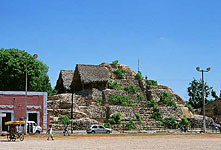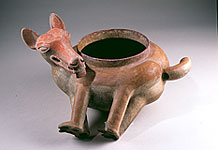
Acanceh, Yucatan.
Decorated with orange slip, the squash effigy vessel has an incised hieroglyphic text stating that it is a drinking vessel for b'ukutz kakaw, a chocolate-based drink served at feasts and offered to the gods. The text ends with an emblem glyph or place name of Akankeh, the Yucatecan town still known today as Acanceh.
Squash Effigy Vessel.
Mexico, Yucatan Peninsula, Acanceh, AD 450-550.
Ceramic with orange slip.
14.1 x 17.5 cm.
CNCA-INAH, Museo Regional de Yucatan, "Palacio Cantón," Merida, Mexico.
|
|
Feasting and gift-giving were integral to Mesoamerican social and political events, including heir designation and accession ceremonies, war victory celebrations, marriages, and religious observances. Kings established and maintained personal and political relationships by providing generous quantities of fine food and drink for their guests, and by giving gifts, thus openly conveying power and success. By participating in such feasts, guests accepted future obligations to provide economic and political support to the ruler, further solidifying his power. Vessels developed from relatively simple forms in the Formative period to elaborate sculpted forms in the Early Classic. Vessels used during sumptuous feasts included basins, large platters, covered dishes, cylindrically shaped drinking vessels, and effigy forms, such as a serving vessel in the form of a deer.
Pinole is made from cacao and ground maize, and the residue of both were discovered inside the deer effigy vessel (McNeil et al., "Cacao in Copan," in McNeil, ed., The Origins of Chocolate: Cacao in the Americas, in press.).

|
Vessel in Form of Deer.
Copan, Honduras.
Structure 16, Tomb of K'inich Yax K'uk' Mo'.
25 x 39 cm.
IHAH, Copán.
|
|